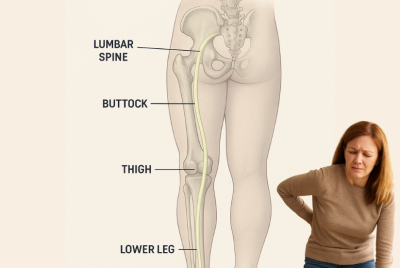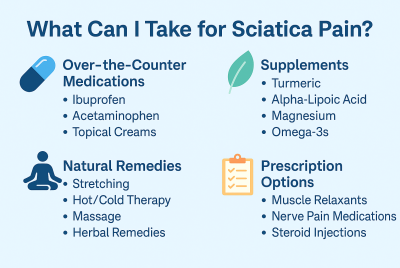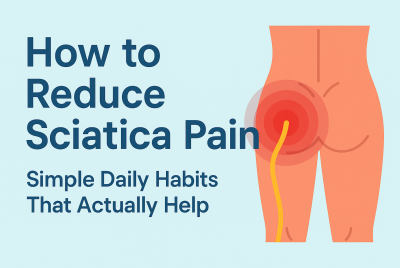Heat or Ice for Sciatica? When to Use Each for Pain Relief
If you’re struggling with sharp, burning, or radiating pain from your lower back down your leg, chances are you’re dealing with sciatica, a condition that can disrupt your daily life and sleep. One of the most frequently asked questions is: “Should I use heat or ice for sciatica nerve pain?”
The truth is, both heat and cold therapy can be effective, but it depends on the timing, cause of your pain, and your body’s response.
In this article, we’ll explore:
-
The key differences between heat and cold therapy
-
When to use each
-
Tips for best results
-
Recommended products that can bring quick relief
🔍 Quick Comparison: Heat vs. Ice for Sciatica
| Therapy | How it works | Best for | When to use |
|---|---|---|---|
| ❄️ Cold (Ice) | Reduces inflammation, numbs pain | New or acute flare-ups | First 24–72 hours of pain |
| 🔥 Heat | Relaxes muscles, increases blood flow | Chronic or lingering tension | After inflammation subsides or for long-term relief |
Sciatica can be triggered by:
-
A herniated disc
-
Piriformis syndrome
-
Spinal stenosis
-
Muscle strain or spasm
Understanding the cause helps determine whether cold or heat will give you the most relief.
Heat or Ice for Sciatica Nerve Pain
❄️ When to Use Cold Therapy for Sciatica
Cold therapy (also called cryotherapy) is ideal during the initial onset of pain, especially if it’s sharp, sudden, and linked to inflammation or swelling.
✅ Cold works best when:
-
Your sciatica just started (within 1–3 days)
-
The pain is intense and shooting
-
There is visible swelling or muscle tightness
-
You’ve recently aggravated your back with a movement or injury
🧊 How Ice Helps:
-
Numbs the sciatic nerve, reducing pain signals
-
Decreases inflammation in tissues pressing on the nerve
-
Slows nerve conduction, calming down spasms and sharp jolts
💡 Cold Therapy Tips:
-
Use a gel ice pack, frozen peas, or a cold compress
-
Wrap in a towel—never apply ice directly to skin
-
Apply for 15–20 minutes at a time
-
Repeat every 2–3 hours during the first 48–72 hours
Pro Tip: Place the ice pack on your lower back, not your leg. That’s where the nerve originates.
🔥 When to Switch to Heat for Sciatica
Once the acute pain and inflammation subside (typically after 2–3 days), it’s time to introduce heat therapy.
Heat helps with muscle relaxation, increased circulation, and tissue healing—all important for chronic sciatica pain or tension caused by tight muscles (like the piriformis).
✅ Heat works best when:
-
Your pain is dull, achy, or lingering
-
You feel stiffness in your back, hips, or legs
-
The sciatica is caused by muscle tension, not swelling
-
You’re past the acute phase (after the first few days)
🔥 How Heat Helps:
-
Relaxes tight muscles that may be compressing the sciatic nerve
-
Increases blood flow, speeding up healing
-
Eases stiffness and spasms, especially after inactivity or in the morning
💡 Heat Therapy Tips:
-
Use a moist heating pad, hot water bottle, or warm towel
-
Apply for 15–30 minutes at a time
-
Try heat before stretching or exercising to loosen muscles
-
Use evening heat therapy to relax before bed
Important: Don’t use heat during the early stages of inflammation—it can make swelling worse.
⏱ Best Practices and Timing for Using Heat & Ice
Here’s a simple guide to help you decide when to use heat or cold based on your situation:
| Situation | Use Ice | Use Heat |
|---|---|---|
| Pain started recently (under 3 days) | ✅ Yes | ❌ No |
| Chronic back stiffness | ❌ No | ✅ Yes |
| After exercise or physical therapy | ✅ Yes | ✅ Yes (as needed) |
| Before stretching or yoga | ❌ No | ✅ Yes |
| Woke up with a stiff or achy back | ❌ No | ✅ Yes |
| Sharp, shooting pain down the leg | ✅ Yes | ❌ No |
Some people benefit from alternating hot and cold therapy, known as contrast therapy. This helps reduce inflammation while also improving blood flow.
🔁 How to Alternate:
-
Ice for 15 minutes
-
Wait 30 minutes
-
Heat for 15 minutes
-
Repeat 1–2 cycles, once or twice daily
Always observe how your body reacts. If pain worsens, stop and consult a healthcare professional.
🛠 Tools & Products That Work Best
Here are some of the top-rated products for heat and cold therapy relief at home:
✅ Best for Cold Therapy:
-
Reusable Gel Ice Packs – Flexible and moldable, great for the lower back
-
Cold Compression Wraps – Combine cold and compression for deeper relief
-
Cryo Massage Balls – Roll on trigger points in the hip or piriformis
✅ Best for Heat Therapy:
-
Microwaveable Heat Pads – Convenient, soft, and portable
-
Electric Heating Pads with Auto Shutoff – Safe and adjustable
-
Infrared Heating Belts – Deeper tissue penetration, ideal for chronic sciatica
-
Warm Epsom Salt Baths – Great for full-body relaxation and magnesium boost
Bonus Tip: Always keep a barrier (like a towel or clothing layer) between your skin and the heat/cold source to avoid burns or frostbite.
❓ FAQs About Heat or Ice for Sciatica Nerve Pain
1. Is it safe to sleep with a heating pad for sciatica?
Only if it has an automatic shutoff feature. Otherwise, avoid overnight use to prevent burns.
2. Can I use ice and heat together?
Yes—alternate them with proper timing to reduce inflammation and improve circulation.
3. Where should I apply heat or ice for sciatica?
Apply to your lower back, not your leg. The source of sciatic pain is usually spinal or muscular.
4. Can I use cold therapy weeks after my pain started?
Yes, if inflammation or pain flares return, cold therapy is still helpful.
5. What if neither ice nor heat helps?
If your symptoms persist or worsen, consult a specialist. You may need physical therapy, medication, or imaging.
🧠 Final Thoughts on Heat or Ice for Sciatica Nerve Pain
Both heat and ice therapy have powerful benefits when used at the right time for sciatica relief. Ice is your go-to for acute pain and inflammation, while heat excels at relaxing muscles and improving circulation during recovery or chronic episodes.
Knowing when and how to apply each can significantly reduce your discomfort and help you move with more ease. Combine hot/cold therapy with gentle movement, stretching, and supportive posture, and you’ll be on the path to lasting relief.
Disclaimer
Please note that this article should not replace professional medical advice. Consult a healthcare professional for an accurate diagnosis and tailored treatment plan.
👉 Next Reads:





